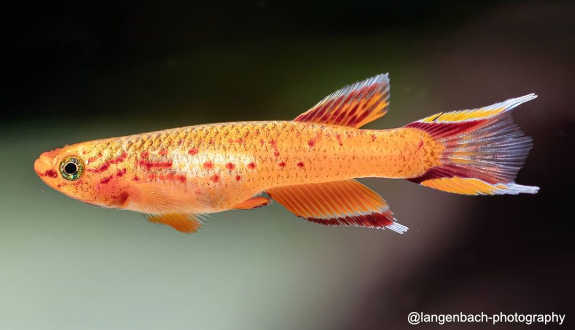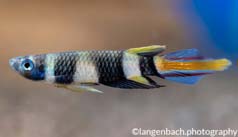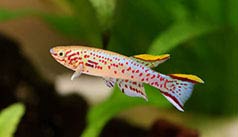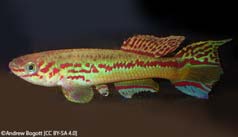

Alternative species (click on the thumbnail to see the card)
Names
Scientific name
Aphyosemion australe
Aphyosemion australe hjerresensii
Aphyosmion calliurus australis
Aphyosemion hjerresensii
Aphyosemion polychromum
Aphysemion australe australe
Haplochilus calliurus australis
Panchax polychromus
Common name
Golden panchax
Lyretail panchax
Cape Lopez lyretail
Origin

Origin: Congo Basin, Gabon, Zaire
Biotope: Not specific
Dimorphism

Females are slightly smaller than males and much less colourful..
Group

Cynolebiidae (Nothobranchiidae)
Volume

20 L / 4 imp gal / 5 US gal
Parameters

T°: 18 to 23°C or 64 to 73°F
pH: 6 to 7
Hardness: 5 to 10°dGH
Difficulty

Facile/p>
Size

Female: 4cm (1.6") - Male: 5cm (2")
Longevity

2 to 3 years
Living zone
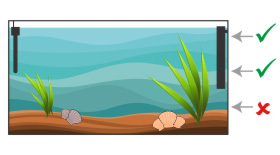
Middle and Top
Individuals

3 (harem)
Food
How to feed the Aphyosemion australe?
Food
How to feed the Aphyosemion australe?
Most of its diet will consist of live or frozen prey. It is a strictly carnivorous fish. The basis of its diet will be composed of artemia, tubifex, daphnia (red daphnia improve the coloration of fish!), mud worms, mosquito larvae...
As a supplement, you can give it classic freeze-dried food. Meals will be distributed in small quantities twice a day.
Behavior
What kind of behavior does the Aphyosemion australe have?
Behavior
What kind of behavior does the Aphyosemion australe have?
Like most Aphyo, Killies males are ardent Romeo's. Indeed, they're very pushy towards the females. Always take more females than males to dilute this behaviour (at least 2 females for every male). Also note that if there are too few females, the males can become aggressive towards each other and may nibble their fins.
Generally speaking, they are peaceful but sometimes lively fish. Paradoxically, they are shy and like to be able to hide. If they are uncomfortable in their aquarium, they may even appear inactive.
They like to spend time hidden among the Java moss (Taxiphyllum barbieri) or Singapore moss (Vesicularia dubyana). These plants give them confidence.
Cohabitation
Who can live with the Aphyosemion australe?
Cohabitation
Who can live with the Aphyosemion australe?
This species will be more at ease in a specific aquarium, especially if it is of small volume (20 to 60 litres / 4 to 13 Imp Gal / 5 to 16 US Gal).
If you still want to install it in a community aquarium, plan for a larger aquarium and do not associate it with fish that are too lively or too active. Instead, use small, quiet fish.
It should never be associated with other species of Killies because of the risk of hybridization (which has the longest history of completely denaturing "pure" strains). If you have hybrids, don't release them in order to preserve the strains.
Breeding
How to breed the Aphyosemion australe?
Breeding
How to breed the Aphyosemion australe?
The reproduction of this species is quite easy. The fish are mature for reproduction as early as 6 months of age. Recommended water parameters are a temperature of 21°C (70°F) and a pH of 6.5. Install mops or Java moss as egg-laying support that you will let float on the surface. Also provide hiding places. To stimulate spawning, feed your fish with live prey.
During the whole breeding season, healthy females can lay up to 10 eggs per day. The eggs are very strong and will stick to plants. After laying, you can retrieve the eggs and place them in a special breeding aquarium. This tank will be filled with water from the parent tank. It can simply be fitted with a small sponge filter on an air pump to ensure the water is stirred. No need for lighting.
Another method: isolate the trio (1 male and 2 females) in the rearing tank and remove them once they have laid their eggs.
The eggs can develop in 3 cm of water. Incubation time: about 15 days at 22°C (72°F) to 3 weeks depending on the temperature (the warmer the water, the shorter the incubation time). Incubation should take place in the dark. Sexing is possible from 2 months.
Fry feeding: artemia nauplia and microworm.
Its aquarium
Which aquarium for the Aphyosemion australe?
Its aquarium
Which aquarium for the Aphyosemion australe?
In the wild, it lives in low water currents and covered with vegetation.
To reproduce these conditions in captivity, plan a well planted tank with many hiding places (root, coconut, stones...). Floating plants and mosses will also be welcome to naturally dim the lighting. Note however that lighting is not mandatory for this fish, but may be useful depending on the plants you choose. Ideally, use a dark soil on which you can place a few dried oak leaves (they will acidify the pH a little, which is desirable).
Even though they are tropical fish, killies prefer water that is not too warm. Moreover, they do not tolerate very hot weather (beware of summer heat waves). For this reason, the killies aquarium does not necessarily have an immersion heater. They also like aged water and the filter is not mandatory either, provided you take good care of your aquarium (change 15% of the volume of the aquarium every week)! If you install a filter, make sure that it does not create too much current.
To sum up, lighting, filter and immersion heater are not mandatory in the good maintenance of this species. Have you recognized the LowTech technique? It is perfectly adapted to this species!
Excellent jumpers, protect your lighting and cover your aquarium well, otherwise you will find them roasted or dried out!
Good To know
Find all additional information!
Good To know
Find all additional information!
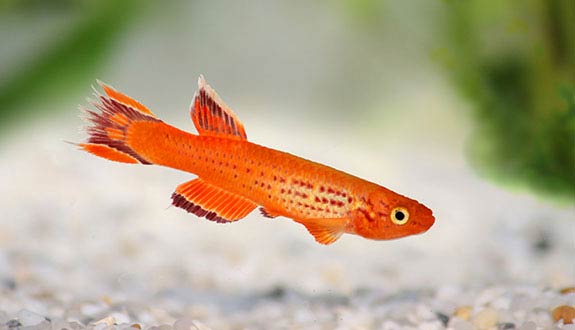
Killies' eggs are very hardy and can survive a dry period (out of water). Exchanges between amateurs can take place during this period!
Its common name "Cap Lopez" refers to the tip of the Ogoué Delta (Africa).
Robust and not very demanding, this species can be proposed to beginner aquarists.
The "wild" colour tends more towards brown (chocolate).
Wild Aphyosemion australe
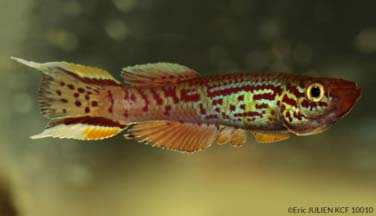
The most common golden colour (gold) is the result of a selection. There is also an orange variety and a spotless (orange or gold, without the red dots).
Orange Aphyosemion australe
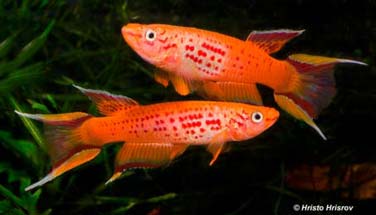
Gold Aphyosemion australe
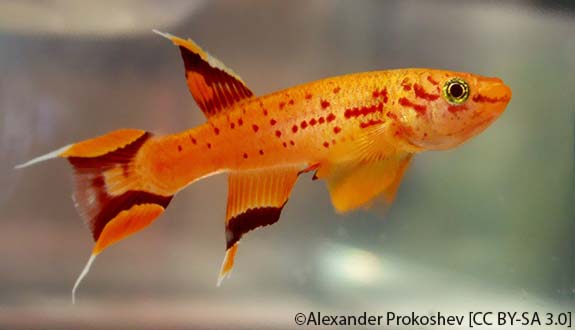
Spotless Aphyosemion australe
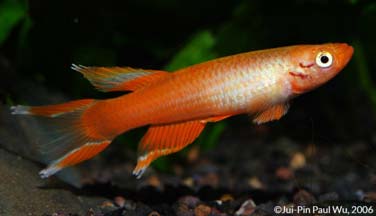
Yours photos!
Comments
Sort by:
Please login to post comments
